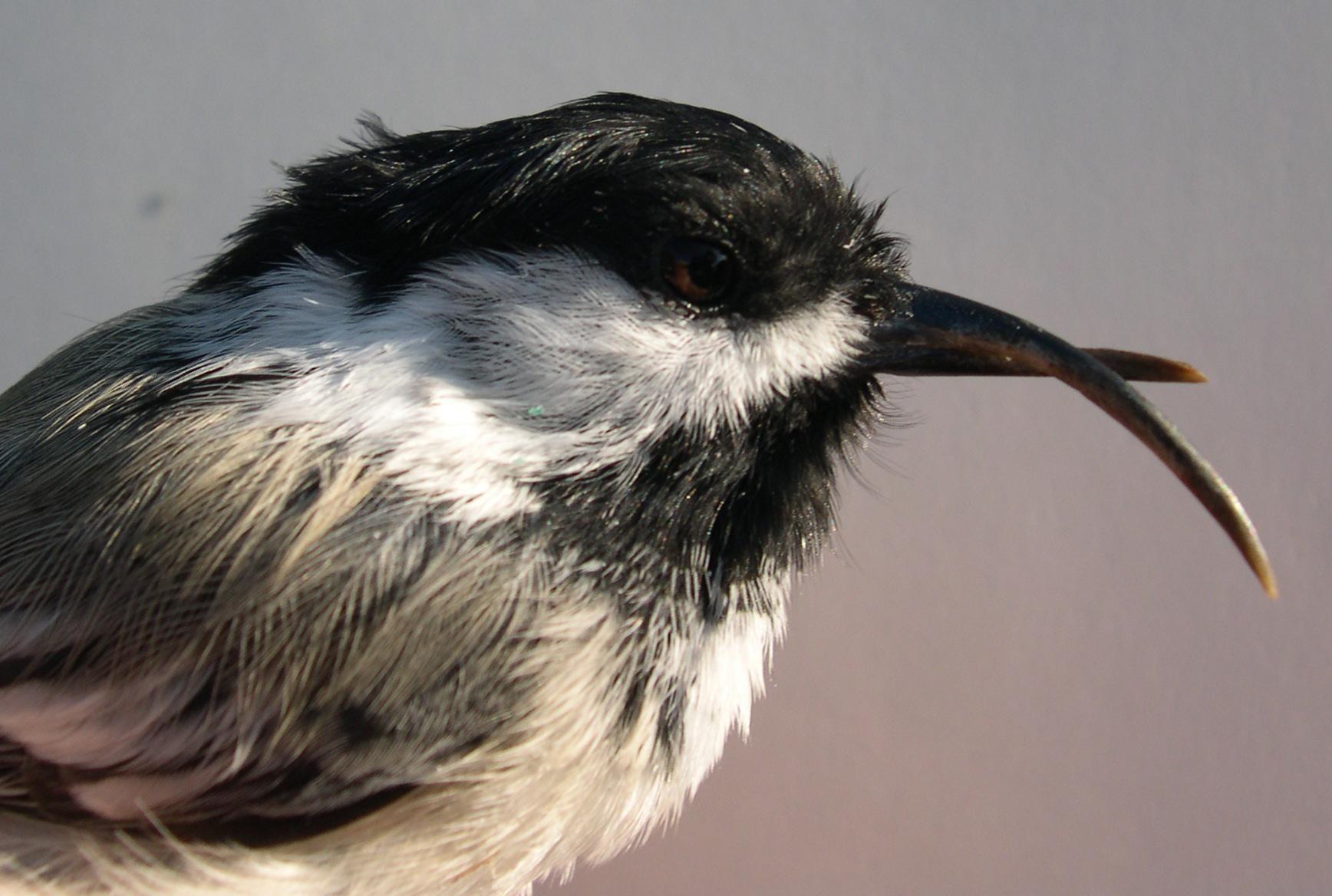
(Photo courtesy of Colleen Handel)
It’s been almost 20 years since large numbers of birds with unusually long beaks first appeared in Alaska.
The birds, whose beaks grow at twice the normal rate, often die from starvation because they can’t feed themselves. Researchers now believe a virus may be causing the beak deformities.
Homer resident Michael Craig first noticed a deformed bird at his feeder about six years ago. It was a black-capped chickadee, and he knew right away that something wasn’t right.
“I watched it over a period of perhaps three months,” Craig said. “I watched the bill growing longer and longer and watched it having more and more trouble getting sunflower seeds.”
Each day, the chickadee returned to Craig’s bird feeder. As he watched, its beak grew almost two inches long – about four times longer than normal. Over time, it began to look a little scruffy.
“Where normally their feathers are smooth, it was just rough. I mean, it was little feathers sticking up all over the place. And at the time, we had not a clue what was going on,” Craig said.
Normally, beak deformities occur in less than 1 percent of wild birds. But in Alaska, researchers have found so-called “twisted beaks” in over 6 percent of black-capped chickadees and 17 percent of northwestern crows.
Wildlife biologist Colleen Handel works at the USGS Alaska Science Center in Anchorage.
She’s been investigating this issue for nearly 20 years.
Handel said beak deformities can be debilitating for birds, because they can’t pick up seeds or crack them open. Birds with deformed beaks also have trouble grooming themselves.
“Their feathers will get dirty and matted,” Handel said. “A lot of them look like they have a mohawk. They just can’t keep their feathers clean. Essentially they lose their little down jacket in the wintertime and they can’t stay warm enough to stay alive.”
Handel and her colleagues think they may have finally pinned down the cause of the beak deformities: a virus.
“In 100 percent of the birds with the beak deformities that we tested, 100 percent of those birds had this virus present,” Handel said.
But what virus was it?
Every organism has a unique genetic code – like a fingerprint. To identify the virus, Handel and her colleagues used a computer library of known genetic sequences and looked for a match.
“What we found was there was no perfect match for this virus,” Handel said.
Scientists have never seen this particular virus before, but it’s related to a family of viruses that affect ducks, chickens and other domesticated birds.
Handel points out that just because birds with deformed beaks have this virus, we can’t assume it causes the deformity. The next step is to test whether birds experimentally infected with the virus develop beak deformities.
“This new discovery of the virus is the strongest lead we’ve had thus far,” Handel said. “We’re really excited that we’ve actually found the cause, so now the fun begins in terms of designing an experiment to demonstrate whether or not it actually is causing them.”
She’s dedicated years of her career to solving the mystery of beak deformities in Alaska’s birds, but Handel said that’s the just the nature of science.
“It does tell the story of how long sometimes scientific research takes to unfold the answers and part of it is persistence,” Handel said. “Part of it is also technological advances. These techniques that we’re using now for genetic screening, we didn’t have those 20 years ago.”
Her research team isn’t wasting any time. They’re already planning their next study to determine whether the newly-discovered virus causes beak deformities in birds.
If you see a bird with a deformed beak, you can report it online to researchers at the USGS Alaska Science Center.
Shahla Farzan is a reporter with KBBI - Homer.
Shahla first caught the radio bug as a world music host for WMHC, the oldest college radio station operated exclusively by women. Before coming to KBBI, she worked at Capital Public Radio in Sacramento and as a science writer for the California Environmental Legacy Project. She is currently completing her Ph.D in ecology at the University of California-Davis, where she studies native bees.
When she's not producing audio stories, you can find Shahla beachcombing or buried in a good book.




